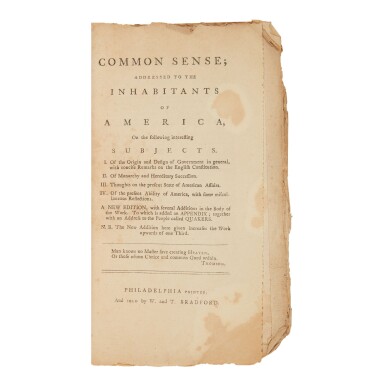Paine, ThomasCommon Sense; With the Whole Appendix, the Address to the Quakers, also, the Large Additions. Philadelphia: R. Bell, 1776
8vo (205 x 126 mm). Light spotting to half title, intermittent foxing and toning minor dampstaining to last few leaves, final blank detached. Disbound.
The third edition, published about two months after the first edition and with Bell's unauthorized printing of the Additions.
Paine wrote this treatise in favor of America gaining independence that distilled, for the first time, the arguments against the British monarchy and presented them to the American public in an accessible and spirited manner. "Paine's Common Sense, published anonymously in January, 1776, was the first vigorous attack on King George, a 'hardened, sullen-tempered Pharoah,' Paine called him, and the first public appeal for an American Republic. It is not too much to say that the Declaration of Independence of July 4, 1776, was due more to Paine's Common Sense than to any other single piece of writing" (Grolier American 14).
"The decision to declare independence was not an easy one. Americans were tied by kinship, culture and commerce to England... During the winter of 1775-1776, many Americans remained confused by recent events and uncertain about what action the colonies ought to take... In a crisp, vigorous style, Paine told Americans what they had been waiting to hear. In a few short pages he summarized the case against the institution of monarchy and presented an argument for American independence that was elegantly yet so simply stated that it could be understood by nearly every American. Common Sense was by far the most influential tract of the American Revolution, and it remains one of the most brilliant pamphlets ever written in the English language" (A Covenanted People, 27).
The first edition was published in Philadelphia by Robert Bell and advertised in the Pennsylvania Evening Post on 9 January 1776. Paine wanted to give his share of the profits toward the purchase of mittens for the American troops engaged in battle in Quebec. However, Bell told Paine that there had been no profits from the first edition, causing Paine to dismiss his publisher and employ Bradford to bring out a new edition, with additional material, at half the price of Bell's printing. Bell retorted by bringing out a new edition before Bradford's, with the Additions. Bell and Paine competed for sales fiercely, both advertising their editions in the Pennsylvania Evening Post, adding to the fervor surrounding the pamphlet and making it all the more famed.
REFERENCE:Gimbel CS-9
Paine, ThomasCommon Sense; With the Whole Appendix, the Address to the Quakers, also, the Large Additions. Philadelphia: R. Bell, 1776
8vo (205 x 126 mm). Light spotting to half title, intermittent foxing and toning minor dampstaining to last few leaves, final blank detached. Disbound.
The third edition, published about two months after the first edition and with Bell's unauthorized printing of the Additions.
Paine wrote this treatise in favor of America gaining independence that distilled, for the first time, the arguments against the British monarchy and presented them to the American public in an accessible and spirited manner. "Paine's Common Sense, published anonymously in January, 1776, was the first vigorous attack on King George, a 'hardened, sullen-tempered Pharoah,' Paine called him, and the first public appeal for an American Republic. It is not too much to say that the Declaration of Independence of July 4, 1776, was due more to Paine's Common Sense than to any other single piece of writing" (Grolier American 14).
"The decision to declare independence was not an easy one. Americans were tied by kinship, culture and commerce to England... During the winter of 1775-1776, many Americans remained confused by recent events and uncertain about what action the colonies ought to take... In a crisp, vigorous style, Paine told Americans what they had been waiting to hear. In a few short pages he summarized the case against the institution of monarchy and presented an argument for American independence that was elegantly yet so simply stated that it could be understood by nearly every American. Common Sense was by far the most influential tract of the American Revolution, and it remains one of the most brilliant pamphlets ever written in the English language" (A Covenanted People, 27).
The first edition was published in Philadelphia by Robert Bell and advertised in the Pennsylvania Evening Post on 9 January 1776. Paine wanted to give his share of the profits toward the purchase of mittens for the American troops engaged in battle in Quebec. However, Bell told Paine that there had been no profits from the first edition, causing Paine to dismiss his publisher and employ Bradford to bring out a new edition, with additional material, at half the price of Bell's printing. Bell retorted by bringing out a new edition before Bradford's, with the Additions. Bell and Paine competed for sales fiercely, both advertising their editions in the Pennsylvania Evening Post, adding to the fervor surrounding the pamphlet and making it all the more famed.
REFERENCE:Gimbel CS-9












Testen Sie LotSearch und seine Premium-Features 7 Tage - ohne Kosten!
Lassen Sie sich automatisch über neue Objekte in kommenden Auktionen benachrichtigen.
Suchauftrag anlegen